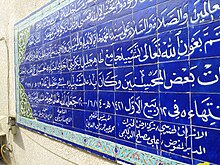Tahir Jalil Habbush
Major General Tahir Jalil Habbush al-Tikriti | |
|---|---|
طاهر جليل حبوش | |
 Habbush as a Major General in 1989 | |
| Director of the Iraqi Intelligence Service | |
| In office 1995–2003 | |
| Preceded by | Sabawi Ibrahim al-Tikriti |
| Succeeded by | Office abolished |
| Director of the Directorate of General Security | |
| In office 1997–1999 | |
| Preceded by | Taha Abbas al-Ahbabi |
| Succeeded by | Rafi Abdul Latif Tulfah |
| Personal details | |
| Born | January 1, 1950 Iraq |
| Occupation | Police officer Intelligence officer |
| Awards | Mother of All Battles Medal |
| Military service | |
| Allegiance | |
| Branch/service | Ministry of the Interior |
| Years of service | 1970–2003 |
| Rank | |
| Unit | Iraqi Police Iraqi Intelligence Service |
| Battles/wars | |
Tahir Jalil Habbush al-Tikriti (Arabic: طاهر جليل حبوش التكريتي; born 1950) is a former Iraqi intelligence official who served under the regime of Saddam Hussein. In 2001, he was Iraq's head of intelligence and as such, informed MI6 in January 2003 (shortly before the start of the Iraq War) that Iraq had no weapons of mass destruction.[1] He was the "Jack of Diamonds" in the US deck of most-wanted Iraqi playing cards[2] and is still a fugitive with a reward of up to $1 million for information leading to his capture.[3] It is believed that al-Tikriti at some point operated from Syria and most likely played a direct role in the day-to-day operations of the insurgency against U.S.-led Coalition forces under the command of Izzat Ibrahim al-Douri.[4]
Forged 2003 Habbush letter
[edit]
According to the London Sunday Telegraph, Mohamed Atta is mentioned in a letter allegedly discovered in Iraq handwritten by Tahir Jalil Habbush al-Takriti, former chief of the Iraqi Intelligence Service. Habbush's July 1, 2001, memo is labeled "Intelligence Items", stating:
To the President of the Ba'ath Revolution Party and President of the Republic, may God protect you.
Mohamed Atta, an Egyptian national, came with Abu Ammer [the real name behind this Arabic alias remains a mystery] and we hosted him in Abu Nidal's house at al-Dora under our direct supervision.
We arranged a work program for him for three days with a team dedicated to working with him...He displayed extraordinary effort and showed a firm commitment to lead the team which will be responsible for attacking the targets that we have agreed to destroy.[5]
The memo is believed to be a forgery. According to Newsweek, "U.S. officials and a leading Iraqi document expert [say] the document is most likely a forgery, part of a thriving new trade in dubious Iraqi documents that has cropped up in the wake of the collapse of Saddam's regime."[6] In The Way of the World, author Ron Suskind alleges that the Bush administration itself ordered the forgery. Habbush then supposedly signed the letter, having already been resettled in Jordan with $5 million from the US.[7]
See also
[edit]- List of fugitives from justice who disappeared
- Mohamed Atta's alleged Prague connection
- U.S. list of most-wanted Iraqis
References
[edit]- ^ Richard Norton-Taylor (March 18, 2013). "MI6 and CIA heard Iraq had no active WMD". The Guardian. Archived from the original on 2015-11-04. Retrieved 2015-11-04.
- ^ "Iraq: The spies who fooled the world - BBC News". Bbc.co.uk. 2013-03-18. Archived from the original on 2015-09-25. Retrieved 2015-11-04.
- ^ "Rewards for Justice". Archived from the original on February 15, 2013. Retrieved March 18, 2013.
- ^ Nance, Malcolm (2014). The Terrorists of Iraq: Inside the Strategy and Tactics of the Iraq Insurgency 2003–2014. CRC Press. pp. 70–71. ISBN 978-1498706896.
- ^ [1] Archived May 13, 2008, at the Wayback Machine
- ^ [2] Archived May 16, 2008, at the Wayback Machine
- ^ Allen, Mike (August 4, 2008). "Book says White House ordered forgery". Politico. Archived from the original on 2015-06-09. Retrieved 2015-11-04.
